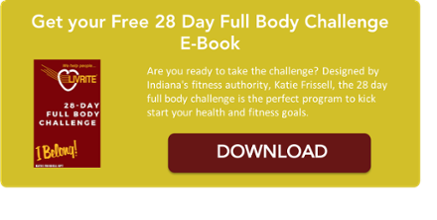Jill Derryberry

Recent Posts
Are you looking to strengthen your abdominals? Whether you want to have a six-pack or improve your balance, there are many reasons to strengthen your stomach muscles and the other muscles around your mid-section that make up your core. Your core muscles are used in just about every movement you make so it is important to keep them strong. If you have extra around your middle, check out my post with 5 tips to lose belly fat.
Here is a fast circuit workout for your core. These are exercises you can do at home or at the gym.
Set your timer for 30 seconds. You'll do each move for 30 seconds, rest for 10 seconds in between each. Rest for a minute then repeat all three exercises two more times.
Here is a basic explanation of each move:
Scissors - Lie flat on your back. You can extend your arms along the sides of your body with your palms pressing into the floor, or you can bend your elbows and place your palms under the back of your head. Pull your navel in towards your spine (engaging your abs) and actively press your lower back flat on the ground. Lift both legs straight up toward the ceiling, continuing to engage your abs and press your lower back into the ground throughout the exercise. Slowly lower your right leg down toward the ground, until it is a few inches above the floor. Then scissor your legs, so you lift your right leg back up as you lower your left leg down towards the ground. Keep this up with slow and controlled movements.
Russian Twist - Sit with your knees bent and heels on the floor. Engage your abs and lean back until your upper body is at a 45 degree angle to the floor, keeping your back long and flat. Rotate your torso, reaching both hands toward the floor on the side before returning back to center then reaching for the other side. A weight or medicine ball can be held and/or feet lifted off the ground to make this more challenging.
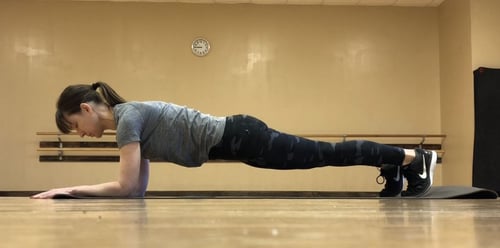
Plank - Lie facedown with legs extended and elbows bent and directly under shoulders; place your hands flat. Feet should be hip-width apart, and elbows should be shoulder-width apart. Contract your abs, then tuck your toes to lift your body (forearms remain on the ground); you should be in a straight line from head to heels. Hold for 30 seconds.
Do this two to three times a week on non-consecutive days for stronger abs!
Looking for more great ab exercises? Take a look at our full list of ab workouts.
Topics: LivRite News, Workouts
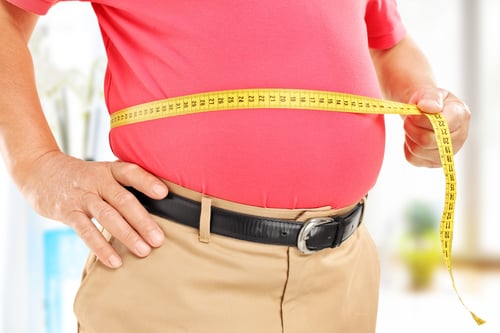
I’ve got good and bad news about belly fat. The bad news is, there isn’t just one move that will get rid of your belly fat. Spot reduction is not possible. Any strength training move for your abs (like crunches) will strengthen those ab muscles but does not necessarily remove the fat over those muscles. The good news is, anything you do to burn calories could contribute to weight loss around your waist.
To remove the excess around your middle, you need to take steps to lose weight, not just crunches or sit ups. This means watching your calorie intake, focusing on non bloating foods and drink, getting in cardio exercise to get your heart rate up and burn calories, strength training and get plenty of sleep. Let's break it down.
1. Watch Your Calories - Very simply, if you burn more calories than you take in, you will lose weight. A 500 calorie deficient each day will result in a loss of a pound a week. Of course that is easier said than done and there are many variables (i.e. hormones, medications) that can affect this simplistic calculation. But bottom line, you won't lose weight if you are eating and drinking too much and that includes any belly fat. I recommend tracking your nutrition in an app like My Fitness Pal.
2. Non-Bloating Foods and Drink - Not only is it important to watch how much you are eating and drinking, it is also important to make sure your calories are healthier and not ones that will naturally make you bloated. Focus on foods with lots of fiber, little saturated fat, lean proteins and only whole grains instead of anything made with white flour. Watch your salt intake and stop or limit soda.
3. Cardio - Many studies show that aerobic exercise helps to get rid of excess weight. A recent study from Duke found that jogging the equivalent of 12 miles a week will help you lose belly fat. You don't have to jog to get this benefit. Anything you are doing to get your heart rate up will help, try to work to the point that you don't want to talk (but could if you needed to) at least 20 minutes a day. Walk fast, take a dance class or kickboxing class. Also, some strength training done in a circuit will elevate your heart rate just as much as steady state cardio. Find the type of aerobic exercise you like, and do that!
4. Strength Training - Adding in strength training at least two times a week is a good thing for everyone but also helps with reducing excess belly fat. The more muscle you have, the higher your metabolism, which means the more calories you burn. Be sure to work all of your muscles with either body weight or weight resistance.
5. More Sleep, Less Stress - According to a 2010 Wake Forest University study, routinely getting 5 hours or less of sleep per night increases visceral fat levels. Aim to get 7-8 hours a night. Getting less increases levels of the stress hormone, cortisol, which is linked to belly fat. Guess what else increases your cortisol levels? Yep, that's right, stress. Be sure to have strategies to reduce your stress like a hobby you enjoy, meditation or talking with a friend.
This is a quick overview of just a few things that may impact your waist line. Also, keep in mind everyone’s body is different. There are other factors that can contribute to weight loss or gain and specifically how your stomach looks. Be patient, work on the five things above and watch your middle shrink!
Looking for great exercises to help tone your body? Check out our exercise library for video instructions on great exercises to add to your routine.
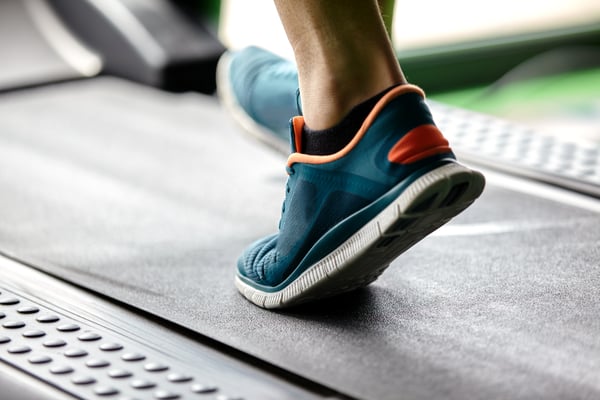
Ready to start exercising? Great! Physical activity benefits your physical and mental health in so many ways, it should be an important part of your lifestyle. However, there is so much information out there, and our lives or so busy already, it can seem overwhelming to begin. It doesn’t have to be so complicated or take up that much time. Whether you are getting back to working out after some time off, or are beginning an exercise habit for the first time, here are some things to keep in mind as you get started.
Four Workout Tips for Beginners
1. Get Physical – a physical that is. You might need an actual physical from your doctor before you start exercising. Anyone with major health issues or health risks should get clearance from their doctor prior to beginning any exercise routine. No matter your medical condition, you can probably workout in some way. But it’s best to get those details and any restrictions from your doctor.
2. Set A Goal – What is your workout goal? Do you want to run a 5k? Lower your blood pressure? Hold a plank for a minute? Think of goals that are specific and measurable that you can work toward and achieve in a shorter period of time. For example, instead of saying a large overarching goal like “workout more” or “lose 100 pounds”, make a starting more specific goal of exercising twice a week.
3. Start Slow – Starting out too aggressively may result in injury. Doing too much too soon is not good for your body and will not provide instant results. Exercise should be a lifelong habit so it should be sustainable and something you can stick with. Slowly progress the time you exercise and the weight you use.
4. Plan a Balanced Routine – a good exercise routine will contain some cardiovascular activity, strength conditioning and stretching.
- When starting out with cardiovascular activity like walking, running or the elliptical, shoot for 20-30 minutes at a pace where you can carry on a conversation if you had to but couldn’t sing a song. If you can sing, you aren’t going fast enough. For heart health, the American Heart Association recommends 30 minutes of moderate intensity physical activity on most days of the week. According to the CDC, moderate intensity means your heart rate should be between 50% - 70% of your maximum heart rate. An approximate way to calculate your maximum heart rate is to subtract your age from 220.
- Strength conditioning should be done at least twice a week. Start with working each major muscle group with a weight that you can lift for 10-12 repetitions with the last reps being very difficult. Don’t work the same muscle group on consecutive days and be sure to warm up with a 5 minute walk or other dynamic activity prior to strength training.
- Stretching should be done after each workout. Static stretches for each major muscle group should be held for 10-30 seconds.
Don’t be intimidated by all the information, all of the gym equipment or all the different ways to exercise! It can be as simple as adding walking 20-30 minutes to your day. Follow the tips above to get started. Want more information and to get a workout created especially for you? Contact a LivRite personal trainer today!
Topics: LivRite News
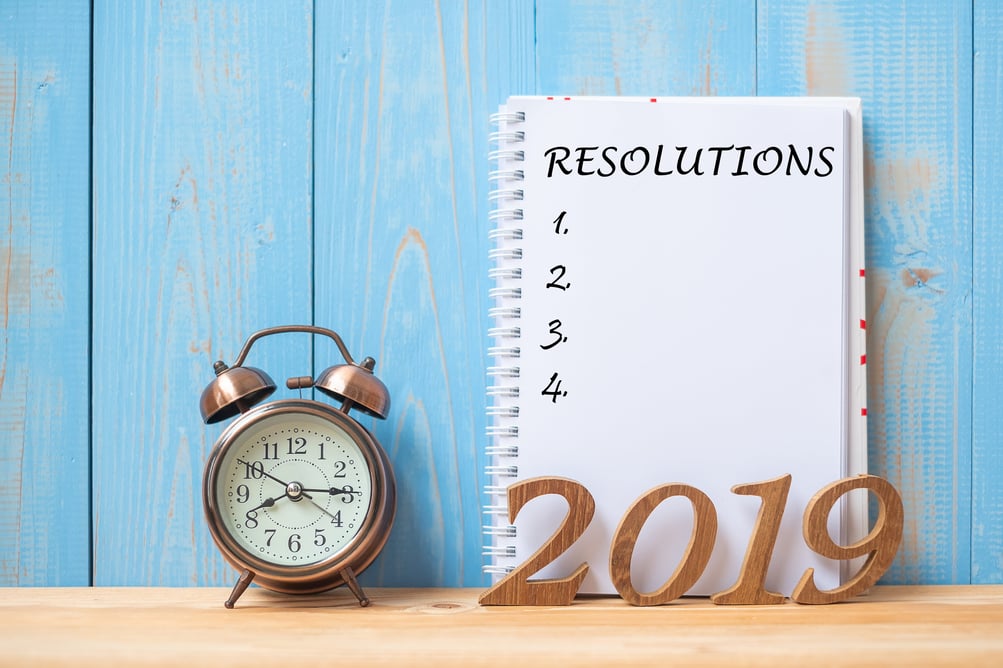
Making a New Year’s Resolution is a great way to make a positive change in your life. But unfortunately, according to U.S. News, approximately 80% of resolutions fail by February. How can you make a lasting change? To be successful at something you would like to achieve, it is important to make sure your resolutions are SMART.
SMART stands for Specific, Measurable, Attainable, Relevant and Time Bound.
- Specific For example, let's say you want to get healthier. Is that specific? Not really. What does being healthier mean to you? Be more specific. Do you want to lower your blood pressure? Get off Diabetes medication? Lose 20 pounds? A specific goal has a much greater chance of being accomplished than a general goal.
- Measurable Now that you have made the goal more specific, it should be easier to measure. Decide to track the goal per week or per month and decide the measures you will use to track. For example, if I want to lose 20 pounds, I will weigh myself once a week with a goal of losing 2 pounds per week. Keeping track of progress gives incentives to keep going.
- Attainable If you don't have the time, money or talent to reach a certain goal you'll fail and be miserable. In some cases of health or fitness resolutions, you may need to consult with your doctor to ensure it is a safe and/or realistic resolution. I heard of someone who resolved to read 75 books in a year. She didn't think about how much time that would actually take and with a full time job, a husband and child, that goal really wasn't realistic for her. However, that doesn't mean that you can't try for something that might sound impossible and make it happen by planning smartly and going for it!
- Relevant Is the resolution something that is important to you? Why do you want to make this change? Goals are more likely to be reached if they are significant to you.
- Time Bound Goals need to have a time limit or date to be reached to help keep you motivated and to establish a sense of urgency to prevent life from getting in the way. Also, if you have a big goal, like losing weight, making small specific goals toward that big objective will be motivating and keep you going. When my resolution was to run a half marathon, the mini marathon training schedule provided built in smaller goals along the way. In the months leading to the mini, having a 5k and 10k set up on specific dates (that I registered and paid for which really helped with accountability!) kept me on track toward the bigger goal of the half marathon and gave me the satisfaction of meeting those achievements as well. Having a deadline or set date makes it more likely it will happen.
Instead of vague resolutions, SMART goal setting creates a set path towards your objective. Every goal or resolution can be made SMART and then will be closer to reality.
Need help with your health and fitness resolution? Schedule a Fitness Assessment with a LivRite trainer today!
Topics: LivRite News
Cardio or Weights: Which is Better For Weight Loss?
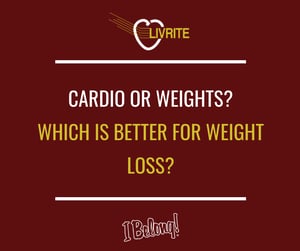
If you are looking to lose some weight you might be wondering what is the fastest and best way to get rid of fat. At the very basic level, to lose weight you need to create a calorie deficit. That is, to burn more calories than you are taking in. Of course, there are many things that can complicate that simple (but not easy to do) equation. Those complications aside, and not taking your nutrition into account, what is the best way to exercise to burn more calories and lose weight? Cardio or Weight Training?
Cardio, like running, the elliptical, brisk walking, a Zumba class or spinning, is great for your heart and does burn more calories per minute than resistance training while you are completing the exercise. The amount of calories expended depends on the type, intensity and duration of the exercise. Keeping your heart rate elevated at a consistent level is called steady state cardio (for example, walking at the same brisk pace for 30 minutes). Varying the intensity of your cardio (for example, sprinting for 1 minute then jogging for 2 minutes) in high intensity intervals (HIT) burns more calories than steady state cardio and does create more calorie burn for up to 24 hours after you exercise due to your body recovering from the high intensity intervals.
Resistance training with weights is important for building and maintaining muscle and bone mass. The more muscle you have, the higher your metabolic rate overall. That means you will burn more calories all the time with more muscle! Also, you will continue to burn calories after a strength training session. With steady state cardio, your calorie burn ends with the exercise. This afterburn created by weight training is due to your body repairing the microscopic muscle tears that happen when you challenge your muscles with weights. These tears will repair and that is how your muscles get stronger.
Which is better for weight loss? It’s a close call, but weights edge out cardio for weight loss when you look at the metabolic effects that occur after weight training. According to a study in the Journal of Science and Medicine in Sport (2017; doi:10.1016/j.sams.2018.02.010), even when a cardio and weight training session burnt the same amount of calories, the group who worked out with the weights had more metabolic effects that could influence long term training results.
For the best results, do both! Both weight training and cardio exercise are important for your overall health. Either combine your cardio and strength training in intervals or complete your strength training then get your cardio in for optimal calorie burn. Choosing the type of these workouts depends on your fitness level and which you like doing. The exercise that will burn the most calories is the one that you will do on a consistent basis!
Have questions about how to plan your workouts for optimal weight loss? Contact a LivRite trainer today!
Looking for great weight training workouts? Take a look at our exercises library for instructional videos.
Topics: LivRite News, Workouts


